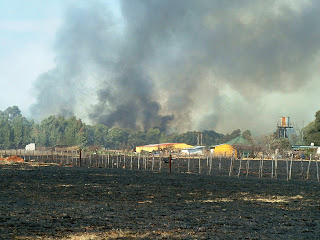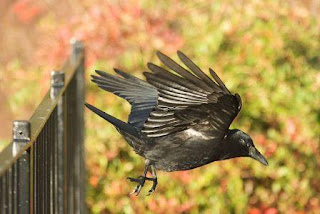Spring fever and summer madness happen on a smallholding over-night. The one minute you're still in the grip of ice cold frost and the next minute the first rains have fallen and everything is blossoming and needs to be cut or trimmed, dug over and fertilized and everything hatches or gets born at the same time.
Calves are frolicking in the field and the ducks and geese are busy leading their ducklings and goslings through the garden on a never-ending search for insects and tasty buds (including the newly-planted seedlings in the bed borders!).
The Koi fish are also spawning in the pond and thousands of tadpoles have hatched to the prior songs of their parents, lullabying us to sleep every night - there is no sound like water bubbling over the waterfall and frogs serenading one another at night to put you into a peaceful state of sleep, awaking fresh and raring to go early the next morning.
Dragonflies appear out of nowhere and provided your pond water is healthy and passes their inspection, lay their eggs in the water, and the next generation lives as Naiads (dragonfly nymphs) under the water for the next couple of months until they crawl out of the water onto some tall
plants, shed their nymph bodies and emerge as the spectacular dragonfly, once again claiming their territory as their parents did before them.
-->
-->
A mole I caught in the garden was
summarily evicted and moved to the other side of the garden wall (I apologise
for the poor image quality, but he was very aggressive and just wouldn't stay
still to be photographed! And those teeth are enough to scare the pants off anybody!)
-->
But now also starts the never-ending fight with the moles, leaving fresh mounds of earth all over your freshly-mowed , immaculate lawn. Our smallholding is totally poison-free, so every home remedy and alternative method for eradicating pests has been tried and tested, from 2L bottles of water lying on the lawn to loud music being pumped down the tunnels to hose pipes filling the tunnels with water (with the assumption that the wet and noisy conditions will be too uncomfortable for them to bear and they will therefore surface on the OTHER side of the wall, out of the garden). Alternatively, one succumbs to the daily mounds of fresh earth, raking them down and all over the lawn as a top soil treatment.

As far as moles are concerned, the Golden Mole is a welcome visitor, as he is carnivorous and eats all the cut worm and other harmful insects, whereas the Rat Mole is the one being chased from pillar to post for his habit of eating the bulbs and roots of everything in his path ... but what a wonderful sight to see a mole surfacing at night, grunting and scratching around under the safe cover of darkness (or so he thought!) until he is swiftly scooped into a bucket (those teeth are lethal!) and released the next morning far away enough to, hopefully, not find his or her way back again (and after much soul-searching and worrying about any possible babies that might be left behind and abandoned, common sense prevailed and hearts were hardened and the thought swept out of our minds in favour of a mole-free garden.)
Snakes are treated with similar love and attention, being caught and released in a far-away, safe environment or, in the case of a Mole snake or Brown House snake, being left to their own devices, as rats can be a big problem on smallholdings with all the food being served up for ducks, geese, chickens, etc.
And so summer, and the life-cycle of a smallholding, starts once again!
.





































